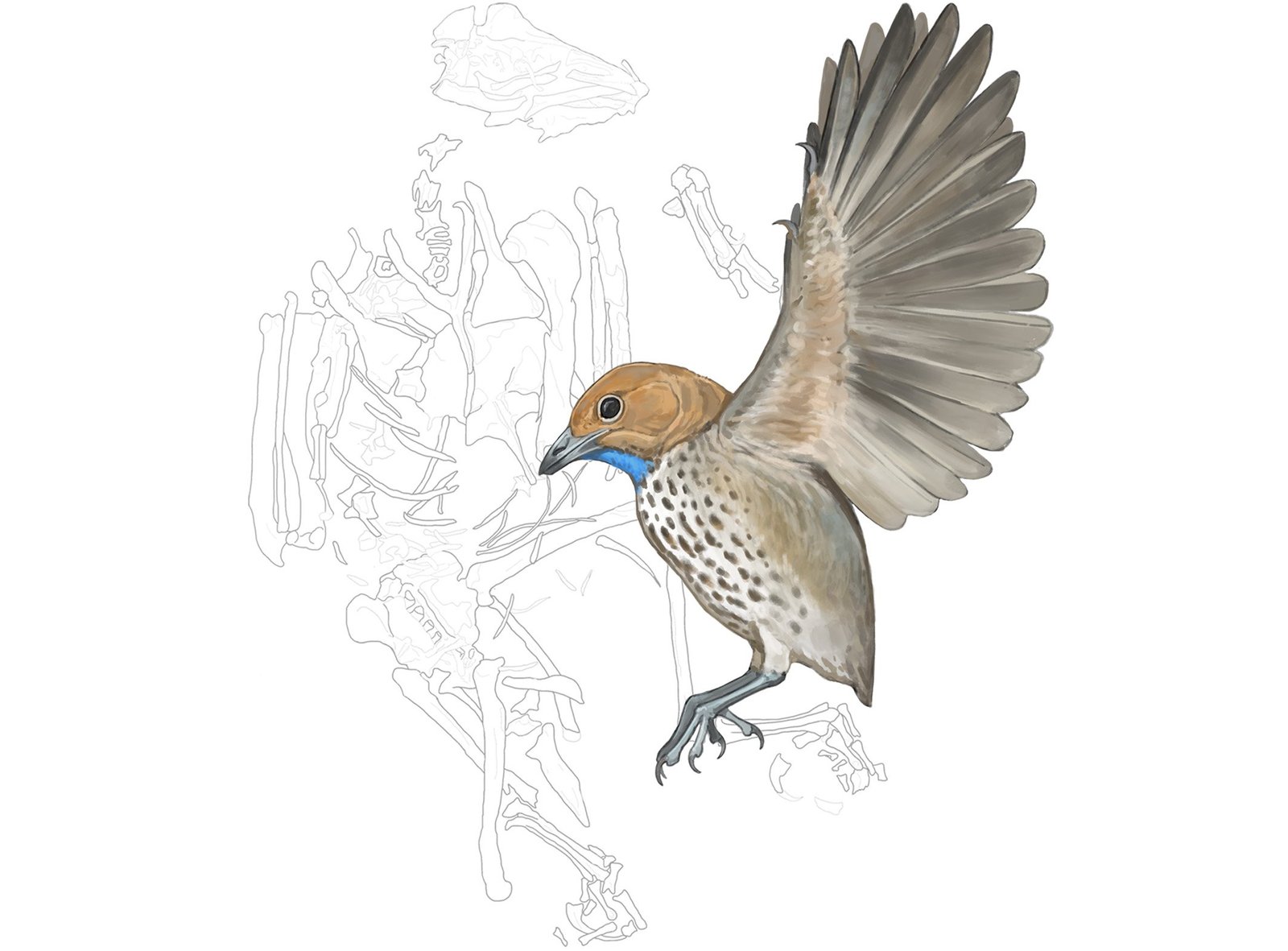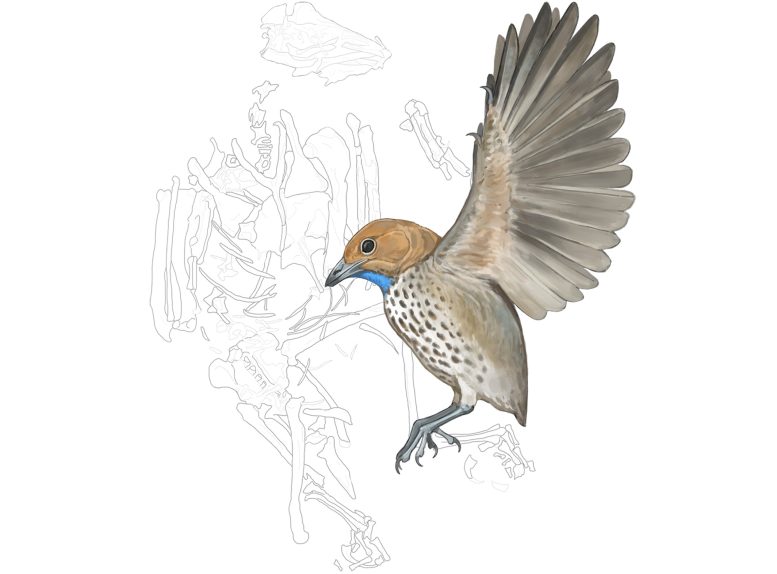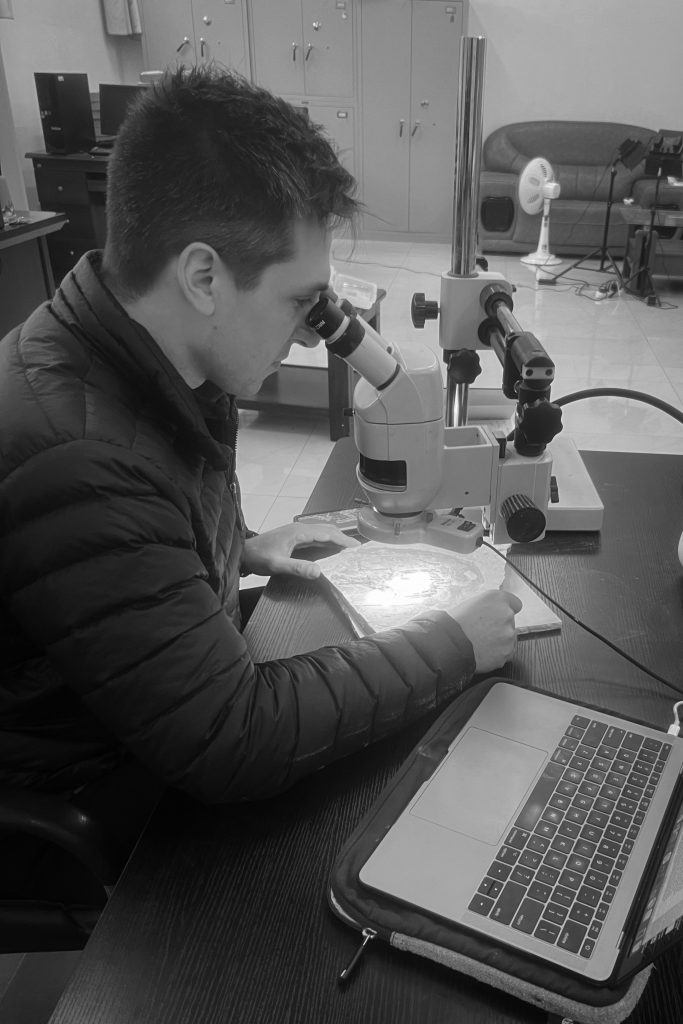
“Attenborough’s Strange Bird” – Scientists Discover Unusual New Species That Defied Dinosaur Extinction
-
by Anoop Singh
- 10

Scientists have discovered a new species of fossil bird, Imparavis attenboroughi which is the first of its kind to have evolved toothlessness. Illustration showing the fossil skeleton of Imparavis attenboroughi, alongside a reconstruction of the bird in life. Credit: Ville Sinkkonen.
No birds alive today have teeth. But that wasn’t always the case– many early fossil birds had beaks full of sharp, tiny teeth. In a paper in the journal Cretaceous Research, scientists have described a new species of fossil bird that was the first of its kind to evolve toothless-ness; its name, in honor of naturalist Sir David Attenborough, means “Attenborough’s strange bird.”
“It is a great honor to have one’s name attached to a fossil, particularly one as spectacular and important as this. It seems the history of birds is more complex than we knew,” says Sir David Attenborough.
All birds are dinosaurs, but not all dinosaurs fall into the specialized type of dinosaurs known as birds, sort of like how all squares are rectangles, but not all rectangles are squares. The newly described Imparavis attenboroughi is a bird, and therefore, also a dinosaur.
An Unusual Discovery
Imparavis attenboroughi was a member of a group of birds called enantiornithines, or “opposite birds,” named for a feature in their shoulder joints that is “opposite” from what’s seen in modern birds. Enantiornithines were once the most diverse group of birds, but they went extinct 66 million years ago following the meteor impact that killed most of the dinosaurs. Scientists are still working to figure out why the enantiornithines went extinct and the ornithuromorphs, the group that gave rise to modern birds, survived.
“Enantiornithines are very weird. Most of them had teeth and still had clawed digits. If you were to go back in time 120 million years in northeastern China and walk around, you might have seen something that looked like a robin or a cardinal, but then it would open its mouth, and it would be filled with teeth, and it would raise its wing, and you would realize that it had little fingers,” says Alex Clark, a Ph.D. student at the University of Chicago and the Field Museum and the paper’s corresponding author.
But “Attenborough’s strange bird” bucked this trend. “Scientists previously thought that the first record of toothlessness in this group was about 72 million years ago, in the late Cretaceous. This little guy, Imparavis, pushes that back by about 48 to 50 million years. So toothlessness, or edentulism, evolved much earlier in this group than we thought,” says Clark.

Alex Clark, a Ph.D. student at the Field Museum and the University of Chicago, examining the fossil he helped describe, Imparavis attenboroughi. Credit: Courtesy of Alex Clark
The specimen was found by an amateur fossil collector near the village of Toudaoyingzi in northeastern China and donated to the Shandong Tianyu Museum of Nature. Clark’s advisor and co-author on the paper, Field Museum associate curator of fossil reptiles Jingmai O’Connor, first noticed something unusual about this fossil several years ago, when she was visiting the Shandong Tianyu Museum’s collections.
“I think what drew me to the specimen wasn’t its lack of teeth– it was its forelimbs,” says O’Connor. “It had a giant bicipital crest– a bony process jutting out at the top of the upper arm bone, where muscles attach. I’d seen crests like that in Late Cretaceous birds, but not in the Early Cretaceous like this one. That’s when I first suspected it might be a new species.”
O’Connor, Clark, and their coauthors in China, Xiaoli Wang, Xiangyu Zhang, Xing Wang, Xiaoting Zheng, and Zhonghe Zhou, undertook further study of the specimen and determined that it did indeed represent an animal new to science.
Insights into Flight and Diet
The unusual wing bones could have allowed for muscle attachments that let this bird flap its wings with extra power. “We’re potentially looking at really strong wing beats. Some features of the bones resemble those of modern birds like puffins or murres, which can flap crazy fast, or quails and pheasants, which are stout little birds but produce enough power to launch nearly vertically at a moment’s notice when threatened,” says Clark.
Meanwhile, the bird’s toothless beak doesn’t necessarily tell scientists what it was eating, since modern toothless birds have a wide variety of diets. Like its fellow enantiornithines, and unlike modern birds, it does not appear to have a digestive organ called a gizzard, or gastric mill, that helped it crush up its food.
While Clark notes that “an animal is more than the sum of its parts, and we can’t fully know what an animal’s life was like just by looking at single components of its body,” he and his coauthors have been able to hypothesize about some of Imparavis’s behavior and ecology, based on the details of its wings, feet, and beak together. “I like to think of these guys kind of acting like modern robins. They can perch in trees just fine, but for the most part, you see them foraging on the ground, hopping around and walking,” says Clark.
“It seems like most enantiornithines were pretty arboreal, but the differences in the forelimb structure of Imparavis suggests that even though it’s still probably lived in the trees, it maybe ventured down to the ground to feed, and that might mean it had a unique diet compared to other enantiornithines, which also might explain why it lost its teeth,” says O’Connor.
Understanding Evolution and Extinction
In the paper, the researchers also revisited a previously described fossil bird, Chiappeavis (which O’Connor named eight years ago after her Ph.D. advisor), and suggest that it too was an early toothless enantiornithine. This finding, along with Imparavis, indicates that toothlessness may not have been quite as unique in Early Cretaceous enantiornithines as previously thought.
Clark said that nature documentaries by Sir David Attenborough, in which the renowned British naturalist narrates the behavior of different animals, were pivotal to his own interest in science. “I most likely wouldn’t be in the natural sciences if it weren’t for David Attenborough’s documentaries,” says Clark, explaining why he chose to name the new fossil after Attenborough.
Clark and O’Connor noted the importance of Attenborough’s messaging that not only celebrates life on earth, but also warns against the mass extinction the planet is undergoing due to human-caused climate change and habitat destruction.
“Learning about enantiornithines like Imparavis attenboroughi helps us understand why they went extinct and why modern birds survived, which is really important for understanding the sixth mass extinction that we’re in now,” says O’Connor. “The biggest crisis humanity is facing is the sixth mass extinction, and paleontology provides the only evidence we have for how organisms respond to environmental changes and how animals respond to the stress of other organisms going extinct.”
Reference: “First Edentulous Enantiornithine (Aves: Ornithothoraces) from the Lower Cretaceous Jehol Avifauna” by Xiaoli Wang, Alexander D. Clark, Jingmai K. O’Connor, Xiangyu Zhang, Xing Wang, Xiaoting Zheng and Zhonghe Zhou, 27 February 2024, Cretaceous Research.
DOI: 10.1016/j.cretres.2024.105867
Scientists have discovered a new species of fossil bird, Imparavis attenboroughi which is the first of its kind to have evolved toothlessness. Illustration showing the fossil skeleton of Imparavis attenboroughi, alongside a reconstruction of the bird in life. Credit: Ville Sinkkonen. No birds alive today have teeth. But that wasn’t always the case– many early…
Scientists have discovered a new species of fossil bird, Imparavis attenboroughi which is the first of its kind to have evolved toothlessness. Illustration showing the fossil skeleton of Imparavis attenboroughi, alongside a reconstruction of the bird in life. Credit: Ville Sinkkonen. No birds alive today have teeth. But that wasn’t always the case– many early…
